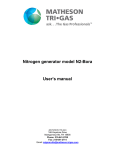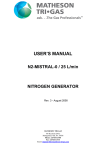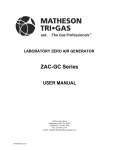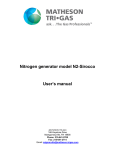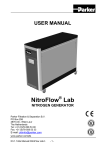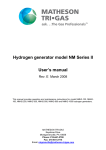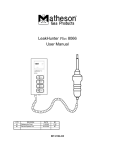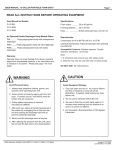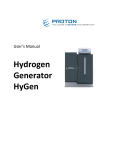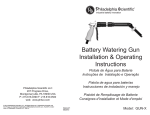Download USER MANUAL - Matheson TRIGAS
Transcript
USER MANUAL LCMS M-4 NITROGEN GENERATOR MATHESON TRI-GAS 166 Keystone Drive Montgomeryville, PA 18936 Phone: 215-641-2700 Fax: 215-641-2714 Email: [email protected] INT-0262-XX rev B 2005 Matheson Tri-Gas All rights reserved No part of this publication may be produced and/or publicized by being printed, photocopied, and/or placed on microfilm or in any other manner without the prior written permission of Matheson Tri-Gas. Matheson Tri-Gas retains the right to make changes in parts at any point without first or directly notifying the customer. The contents of this manual can also be changed without prior warning. This manual is valid for the LCMS M-4 nitrogen generator in its standard version. Matheson Tri-Gas can therefore not be held liable for specifications of the delivered system that may deviate from the standard version. For information concerning adjustments, maintenance or repairs not contained in this manual, please contact Matheson Tri-Gas. INT-0262-XX rev B 2 of 23 USER MANUAL ................................................................................................................................................................................ 1 1 INTRODUCTION ...................................................................................................................................................................... 4 1.1 1.2 1.3 1.4 1.5 1.6 1.7 2 General ........................................................................................................................................... 4 Pictograms in this manual .............................................................................................................. 4 Identification and service ............................................................................................................... 5 Certificates ..................................................................................................................................... 5 Intended uses .................................................................................................................................. 5 User instructions............................................................................................................................. 5 Liability .......................................................................................................................................... 5 HEALTH, SAFETY AND ENVIRONMENTAL COMPLIANCE........................................................................................ 6 2.1 2.2 2.3 2.4 2.5 3 General ........................................................................................................................................... 6 Nitrogen and oxygen ...................................................................................................................... 6 Electricity ....................................................................................................................................... 6 Safety precautions .......................................................................................................................... 6 Environmental aspects.................................................................................................................... 7 DESCRIPTION .......................................................................................................................................................................... 8 3.1 3.2 3.3 3.4 3.5 General ........................................................................................................................................... 8 Separation principle........................................................................................................................ 8 Parts................................................................................................................................................ 9 Process Diagram........................................................................................................................... 10 Process Schematic ..................................................................................................................... 11 TECHNICAL SPECIFICATIONS ......................................................................................................................................... 12 4 4.1 4.2 4.3 5 General ......................................................................................................................................... 12 Production capacity ...................................................................................................................... 13 Maintenance items........................................................................................................................ 13 INSTALLATION ..................................................................................................................................................................... 14 5.1 5.2 5.3 5.4 5.5 6 Transport ...................................................................................................................................... 14 Location........................................................................................................................................ 14 Unpack and check equipment....................................................................................................... 14 Connect to application.................................................................................................................. 14 Start up the LCMS M-4 nitrogen generator.................................................................................. 14 OPERATION............................................................................................................................................................................ 15 6.1 6.2 6.3 7 Start LCMS M-4 nitrogen generator ............................................................................................ 15 Stop LCMS M-4 nitrogen generator............................................................................................. 15 Control panel ................................................................................................................................ 16 TROUBLESHOOTING........................................................................................................................................................... 17 7.1 8 Error list........................................................................................................................................ 17 MAINTENANCE ..................................................................................................................................................................... 18 8.1 8.2 8.3 8.4 8.5 9 10 Maintenance schedule .................................................................................................................. 18 Inlet filter element replacement.................................................................................................... 18 Oxygen sensor replacement.......................................................................................................... 18 Oxygen sensor calibration ............................................................................................................ 19 Pressure switch control................................................................................................................. 20 ELECTRICAL SCHEMATIC ................................................................................................................................................ 22 INDEX ................................................................................................................................................................................... 23 INT-0262-XX rev B 3 of 23 1 Introduction 1.1 General The LCMS M-4 nitrogen generator is a product of Matheson Tri-Gas. This manual forms an integral part of the product. The manual describes the installation, daily operation, maintenance and troubleshooting. Content Read the manual carefully before you start with the LCMS M-4 nitrogen generator. Familiarize yourself with the content. Changes to Product Only execute changes to the LCMS M-4 nitrogen generator after explicit prior written permission by Matheson Tri-Gas. Non-conformance to this rule, as well as any consequential damage, loss and costs are the responsibility of the owner and the user. Information All information in this manual, including additional drawings and technical descriptions, remains the property of Matheson Tri-Gas and may not be used (otherwise than for the use of this product), copied, multiplied or published to or for a third party without explicit prior written permission by Matheson Tri-Gas. 1.2 Pictograms in this manual In this manual the following pictograms are used: Warning A warning shows a hazard that can cause death or serious injury. Follow the instructions. Caution A caution shows a danger that can cause damage to the equipment. Follow the instructions. Electricity High voltage: danger of electric shock. Warning Risk for death due to suffocation Risk of fire Oxygen-enriched air leads to an increased risk of fire in the event of contact with inflammable products. High-pressure risk Follow the instructions with respect to compressed gasses. Environment Instructions with respect to the environment INT-0262-XX rev B 4 of 23 1.3 Identification and service The identification plate is located on the right hand side of the LCMS M-4 nitrogen generator. The identification plate shows the characteristics of the LCMS M-4 nitrogen generator. For service and technical assistance, please contact: MATHESON TRI-GAS 166 Keystone Drive Montgomeryville, PA 18936 Phone: 215-641-2700 Fax: 215-641-2714 Email: [email protected] 1.4 Certificates The LCMS M-4 nitrogen generator meets the following requirements: Subject Directive for electromagnetic compatibility (EMC) Low Voltage Directive Pressure equipment directive (PED) Quality assurance Environmental care 1.5 Applicable standard EN-50081-1, EN50082-2 NEN EN 60204-1 Sound engineering practice ISO 9001:2000 ISO 14001:1996 Intended uses The LCMS M-4 nitrogen generator is intended to make nitrogen out of normal ambient air. The system is based on gas separation membranes. The system is not to be used for any other purpose. Matheson Tri-Gas will not accept any liability for improper use. The LCMS M-4 nitrogen generator is in compliance with the prevailing directives and standards. Only use this LCMS M-4 nitrogen generator in a technically perfect condition, in conformity with the purpose as described above. 1.6 User responsibilities Only well-trained personnel are allowed to work on the LCMS M-4 nitrogen generator. The user must be aware of hazards related to operating the LCMS M-4 nitrogen generator and processes connected to the LCMS M-4 nitrogen generator. The user is responsible for the safety of the personnel. All personnel working on the LCMS M-4 nitrogen generator must have free access to the applicable manuals. 1.7 Liability Matheson Tri-Gas will not accept any liability if: • • • • • • The instructions in this manual are ignored. Replacement parts are used which are not approved by the manufacturer. The LCMS M-4 nitrogen generator is operated incorrectly. The system is fed with other gasses than air. The LCMS M-4 nitrogen generator is modified without notification and authorization of the manufacturer. Maintenance and repair are not carried out according to the instructions. INT-0262-XX rev B 5 of 23 2 Health, safety and environmental compliance 2.1 General Correct use of the LCMS M-4 nitrogen generator nitrogen generator is important for your personal safety and for trouble-free functioning of the LCMS M-4 nitrogen generator. Incorrect use can cause damage to the LCMS M-4 nitrogen generator or can lead to incorrect gas supply. Warning • Read this manual before you start the installation and putting into operation of the LCMS M-4 nitrogen generator. Prevent accidents and damage to the LCMS M-4 nitrogen generator. • Contact your supplier if you detect a problem that you cannot solve with this manual. • Use the LCMS M-4 nitrogen generator only for its intended purpose. Refer to section 1.5. • Only service technicians that are qualified to work on electric and pneumatic equipment, are allowed to do the installation, maintenance and repairs. Unqualified people are not allowed to repair the equipment. Refer to section 1.6. Lift the LCMS M-4 nitrogen generator with a forklift. Follow the instructions for operating the forklift. • Do not tamper or experiment with the equipment. Do not exceed the technical specifications for the LCMS M-4 nitrogen generator. Refer to chapter 4. 2.2 Nitrogen and oxygen The LCMS M-4 nitrogen generator generates nitrogen as a product. Oxygen enriched air is released as waste. Warning • Nitrogen can cause suffocation! • Oxygen-enriched air leads to increased risk of fire in the event of contact with inflammable products. Make sure that there is adequate ventilation at all times! • The LCMS M-4 nitrogen generator is not designed for installation in an explosion proof classified area. • Do not install the LCMS M-4 nitrogen generator in an area where explosive mixtures may occur. 2.3 Electricity Warning • Only service technicians that are qualified to work on electric equipment, are allowed to do the installation, maintenance and repairs. • Disconnect the main power supply before you do the maintenance or repair. • If a service technician has to work on the LCMS M-4 nitrogen generator while electricity is connected then the service technician must be very careful with respect to the electric hazards. 2.4 Safety precautions Warning • Make sure that the ventilation rate is sufficient in the room where the enriched oxygen is ventilated, or lead the enriched air outside. • Keep the ambient temperature between 50 and 95°F (10 and 35 °C). • Install the peripheral equipment, piping and nitrogen storage vessels according to standard procedures. • Do regular maintenance to the LCMS M-4 nitrogen generator, to ensure proper and safe operation. Refer to section 8. • Make sure that instructions concerning health and safety are compliant with the local rules and regulations. INT-0262-XX rev B 6 of 23 2.5 Environmental compliance The use and maintenance of the LCMS M-4 nitrogen generator does not include environmental dangers. Most parts are made of metal and can be disposed in the regular way. The packaging of the LCMS M-4 nitrogen generator is 100% recyclable. Make sure that instructions concerning health, safety and environment are compliant with the local rules and regulations. INT-0262-XX rev B 7 of 23 3 Description 3.1 General The LCMS M-4 nitrogen generator separates compressed air produced by an on-board compressor into nitrogen and an air stream enriched with oxygen. The separation system is based on membranes. 3.2 Separation principle B A C H2O - H2 F O2 N2 S Fig. 3-1: Separation principle A B C D Pressurized air inlet Hollow fiber membrane Separation layer Support layer E F G Nitrogen outlet Fast permeation Slow permeation Ambient air contains nitrogen (78.1%), oxygen (20.9%), argon (1%), carbon dioxide, water vapor and traces of other inert gasses. Pressurized air (A) is led through hollow fiber membranes (B). The various air components diffuse through the porous wall of the membranes. The diffusion rate differs for the various gasses: • Oxygen and water vapor have a high diffusion rate and diffuse rapidly through the membrane wall. • Nitrogen has a low diffusion rate and diffuses slowly through the membrane wall. • Pressurized nitrogen enriched air is released at the outlet of the membranes (E) which can be stored in a nitrogen storage vessel. INT-0262-XX rev B 8 of 23 3.3 Parts front side-view back Fig. 3-2: LCMS M-4 Nitrogen Generator A B C D E F G H I J High/low pressure compressor Hollow fibre membrane (M) Low pressure compressor Inlet carbon filter Power switch Flow control valve (FCV) O2-display Delivery pressure gauge (PI2) Pressure control valve (PCV) Compressed air pressure gauge (PI1) INT-0262-XX rev B K Flow control valve (FVC3) L O2-sensor M Printed circuit board with two digit service display N Pressure switch (PSH) O Fuses P Ball valve (V2) Q Power inlet socket R Main switch S Cooling air exhaust outlet 9 of 23 3.4 Process Diagram The LCMS M-4 nitrogen generator can be connected directly to the application (Fig. 3-3) or to a buffer vessel (Fig. 3-4). Application LCMS M-4 Fig. 3-3 Buffer Vessel LCMS M-4 Application Fig. 3-4 INT-0262-XX rev B 10 of 23 3.5 Process Schematic N1 C LP RKV M PI1 FCV HP PCV PSH PI2 V1 N2 V2 V4 INT-0262-XX rev B Air inlet Inlet carbon filter Air compressor Start up valve Gas separation membrane Membrane pressure indicator Flow control valve Nitrogen compressor Nitrogen pressure relief valve Pressure switch Nitrogen pressure indictor Check valve Nitrogen outlet Ball valve Depressurisation valve 11 of 23 4 Technical specifications 4.1 General Delivery pressure Maximum delivery pressure 115 psig / 8 bar(g) Ambient conditions Temperature 50 to 95 °F / 10 to 35 °C Air quality Normal clean ambient air, relative humidity < 90% Noise level Basic: < 58 dB(A) Dimensions and connections Dimensions (H x W x D) [inch] 27-1/2 x 35-1/2 x 12-1/4 Dimensions (H x W x D) [cm] 70 x 90 x 31 Net weight 204 lbs / 92.5 kg Connections Outlet: 1/4” FPT Electrical data Voltage/frequency 110VAC/60Hz, 230VAC/50Hz Power consumption 1.4 kW Parts LCMS M-4 nitrogen generator Options (on demand) 1x LCMS M-4 nitrogen generator 1x Instruction Manual Storage vessel Table 4-1: General data INT-0262-XX rev B 12 of 23 4.2 Production capacity 4.2.1 Capacity LCMS M-4 nitrogen generator Purity % NLPM* 99.9 7.6 99.7 12 Operation Parameters 99 98 97 18 23 26 99.5 13 96 30 95 32 93 38 Table 4-3: Capacity *Nominal conditions: • Ambient temperature: 68 °F / 20 °C • Ambient pressure: 14.7 psia / 1013 mbar(a). 4.3 Maintenance items Part Maintenance kit • 1x Carbon filter Oxygen sensor INT-0262-XX rev B Part number LCMS-FILT-KIT LCMS-O2-SEN 13 of 23 5 Installation Follow the paragraphs in this chapter to install the LCMS M-4 nitrogen generator. 5.1 Transport Warning • Transport the LCMS M-4 nitrogen generator upright. • Use the original container to transport the unit over long distances. • Lift the LCMS M-4 nitrogen generator with a forklift. • For qualifications of personnel, refer to section 2.1. 5.2 Location IMPORTANT • The LCMS M-4 nitrogen generator contains compressors that generate heat; for optimal performance and lifetime it is necessary that cooling air can be vented without resistance. A minimum clearance distance from walls or other objects of at least 20” (50 cm) on all sides (back, left, right and top) is a necessity; also efficient local ventilation at the unit’s ventilation outlet is highly recommended especially when the unit is installed under a bench Install the LCMS M-4 nitrogen generator on a fixed location. The location must meet following requirements: 5.3 • Minimum clearance of 20 “ (50 cm) on all sides (back, left, right and top) as to facilitate heat removal • Indoors • Dry • Avoid direct exposure to sunlight • Away from heat sources • Properly ventilated room. • Easy accessibly for operating and service Unpack and check equipment 1. Open the packaging. 2. Make sure that all components are delivered. Refer to Table 4-1. 5.4 Connect to application Warning • Do not connect the power at this time. • Make sure that the tubes are free of dust, particles, metal parts and curls, liquids and grease before you connect the LCMS M-4 nitrogen generator. • Connect the outlet of the unit to the application 5.5 1. 2. Set up the LCMS M-4 nitrogen generator Make sure that the connections are correct and fixed properly. Leak-check the connections and tubing between the LCMS M-4 nitrogen generator and the application. INT-0262-XX rev B 14 of 23 6 Operation 6.1 Start LCMS M-4 nitrogen generator 1. 2. 3. 4. 5. Turn the power on to the LCMS M-4 nitrogen generator (switch in the back). Switch on the LCMS M-4 nitrogen generator (switch in the front). It will take 3 minutes before the LCMS M-4 nitrogen generator will start to run. The system is ready for use. The LCMS M-4 nitrogen generator will deliver as much nitrogen as required; excess nitrogen will be vented. 6.2 Stop LCMS M-4 nitrogen generator 1. Switch off the power switch before you perform maintenance. 2. Depressurize the system by venting the nitrogen outlet. 3. Make sure that the system is fully depressurized by checking the pressure gauges in the system. INT-0262-XX rev B 15 of 23 6.3 Control panel The control panel (see Figure 6-1) consists of a display and two buttons [menu] and [reset]). The meaning of the codes (also indicated on the front panel) is as follows: C1 Warming up The heater is warming the module inlet C2 Run System is producing nitrogen C3 Stand by Nitrogen production has been stopped automatically by pressure switch because storage vessel is full. Alarms: A1 Poor nitrogen quality A2 Oxygen sensor failure A3 High internal temperature Figure 6-1 By repeatedly pressing the [menu] button you can scroll through a short cyclic menu of parameters (Figure 6-2). This will not influence the unit. When the function buttons have not been pressed for 2 minutes the display will show the status of the unit. • • • After pressing the [menu] button once the oxygen level will be displayed (range 0.0-9.9 %). After pressing the [menu] button another time the display will show H.0. This indicates the running hours of the compressor(s). The running hours are stored in 5 digits, the first being the digit to the right of the digit (hour). The next digits can be read by pressing the [reset] button twice and writing down the consecutive digits to 5 digits number: e.g. H.0.0.0.1.2. is 12 running hours. Pressing the [menu] button again will return the status indicator. [Menu]: Press the [Menu] button once [Reset]: Press the [Reset] button once Figure 6-2 Cyclic menu structure INT-0262-XX rev B 16 of 23 7 Troubleshooting 7.1 Error list Error Delivery of nitrogen too low or nonexistent Possible cause Ambient temperature is too high Check whether the minimum clearance between the LCMS M-4 nitrogen generator and the walls is large enough. Inlet carbon filter is spent Exchange the inlet filter LCMS M-4 nitrogen generator is switched off Switch on the LCMS M-4 nitrogen generator Leak in piping Check for leaks in the piping. Nitrogen outlet line is blocked. Check/open the outlet line Alarm A1 explained below (poor nitrogen quality) Alarm A2 (oxygen sensor failure) Alarm A3 (high internal temperature) Residual oxygen content too high Possible solution Lower the temperature, if possible explained below • Ambient temperature is too high (over 95°F/35°C). • In-/outlet gratings are clogged. • Cooling fans are not or insufficiently functioning. • Compressors are overloaded. Pressure in nitrogen storage Readjust pressure switch vessel over 8 bar(g) because of erroneous setting of pressure switch Ambient temperature lower than normal Increase temperature or readjust purity Purity setting has changed over time Readjust purity Table 7-1: Error list INT-0262-XX rev B 17 of 23 8 Maintenance 8.1 Maintenance schedule Part Filters Action Replace inlet carbon filter Frequency • 1x per year Oxygen sensor Replace oxygen sensor • 1x per 3 years Table 8-1: Maintenance scheme 8.2 1. 2. 3. 4. 5. 6. 7. 8. Switch off the LCMS M-4 nitrogen generator. Let the system depressurize. Disconnect the inlet filter from the tubing. Unscrew the brackets. Remove the inlet filter. Replace the new filter and fix it with the brackets. Connect the inlet filter to the tubing. Switch the LCMS M-4 nitrogen generator back on. 8.3 1. 2. 3. 4. 5. 6. 7. 8. Inlet filter element replacement Oxygen sensor replacement Switch off the LCMS M-4. Remove the right-side cover from the LCMS M-4. Carefully remove the sensor cap (E). Do not pull at the tube. Unscrew the screw ring (D). Disconnect connector (A). Install the new sensor (C). Switch on the LCMS M-4. Calibrate the oxygen sensor. Refer to §8.4 A B C D E F Fig. 8-1: Replace oxygen sensor INT-0262-XX rev B 18 of 23 8.4 Oxygen sensor calibration 1. Check the sample flow of the sensor (300 cc/min.) coming out of the tube (F) that is connected to the sensor cap (E). The flow can be adjusted with the needle valve (FCV3). 2. Remove the sensor cap (E) and expose the sensor to ambient air. 3. The signal may be monitored using a multimeter inserted in CN2 (fig. 8-3) (across a 10 Ohm precision resistor), or by remote receiver. 4. A small non-metallic screwdriver, with a 1.2 x 0.5 mm tip, is required to adjust the potentiometer. 5. The value should read 174mV. Adjust the oxygen level if the value in the display differs. Turn the small adjustment screw (B) to set the level to 174mV (which corresponds to 20.9% O2 level). 6. Reconnect the tube (F) and the sensor cap (E) with the sensor (C). A B C D E F Fig. 8-2: Calibrate oxygen sensor Fig. 8-3 Oxygen sensor print board INT-0262-XX rev B 19 of 23 8.5 Pressure switch control 8.5.1 Adjusting the pressure switch The pressure switch (PSH) can switch the LCMS M-4 on and off depending on the pressure level in a storage vessel. The pressure switch (PSH) setting can be read at the front of the pressure switch, inside the cabinet of the LCMS M-4. The pressure at which the unit switches off can be read off on the ”range” scale. The switch-on pressure can be set using the ”differential” scale. The switch on pressure is equal to the shut-off pressure minus the differential: Pon = Poff – DIFFERENTIAL The default switch-off pressure is 115 psig (8.0 bar(g)) If desired it may be set to a lower value. Fig. 8-4: Pressure switch INT-0262-XX rev B 20 of 23 8.5.2 Control of the outlet pressure The outlet pressure of the LCMS M-4 nitrogen generator can be controlled in two ways depending on whether the nitrogen is stored in a vessel or not. No storage vessel installed: excess nitrogen will be vented; The LCMS M-4 will run continuously; the pressure switch serves as a safety. To set the PSH for this situation, do the following: • Set the pressure switch such that the switch of pressure is 120 psig (8.5 bar(g)) according to 8.5.1 • Open PCV completely (turn left). • Close the ball valve V2 at the outlet while the system is running. • Adjust the back pressure valve PCV such that the pressure gauge PI2 on the front reads no more than 115 psig (8.0 bar(g)). Lower pressure settings will extend compressor life and reduce power usage. • Open the ball valve V2 at the outlet. Storage vessel installed: excess nitrogen will be stored; The LCMS M-4 will start and stop automatically. To set the PSH for this situation, do the following: • Close PCV completely (turn right). • Set the pressure switch to the desired storage vessel pressure but no more than 115 psig (8.0 bar(g)). Switch-off pressure according to 8.5.1. Lower pressures will extend compressor life and reduce power usage. • Set the differential at 12 psi (0.8 bar). Smaller differentials will result in frequent switching which will shorten the life of the compressors. NOTE: After the unit switches off due to reaching switch off pressure in the storage tank, the unit cannot switch on within 5 minutes after the switch-off. The switch-on delay is there to prevent too frequent startup of the compressors that shorten the compressor life. INT-0262-XX rev B 21 of 23 9 Electrical schematic INT-0262-XX rev B 22 of 23 10 Index A Ambient air, 8 C Capacity, 13 Caution, 4 Certificates, 5 Check equipment, 14 Control panel, 16 Cyclic menu, 16 D Dimensions, 12 Display, 16 E Electrical data, 12 Electrical schematic, 22 Electricity, 4, 6 Environment, 4 Environmental compliance, 7 Error list, 17 H High pressure risk, 4 I Identification plate, 5 Inlet filter, 18 Installation, 14 Introduction, 4 L Liability, 5 Location, 14 M N Nitrogen, 6 O Operation, 15 Oxygen, 6 Oxygen enriched air, 6 P Parameters, 16 Parts, 9, 12, 18 Pictograms, 4 Process schematic, 11 R Risk of fire, 4 Run, 16 S Safety precautions, 6 Separation principle, 8 Stand by, 16 Start, 15 Status indicator, 16 Stop, 15 T Technical specifications, 12 Transport, 14 Troubleshooting, 17 U User responsibilities, 5 W Warning, 4, 6 Maintenance, 18 INT-0262-XX rev B 23 of 23























